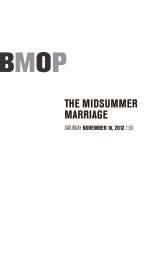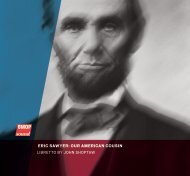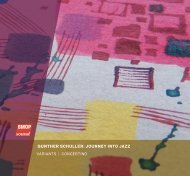Download the album booklet - Boston Modern Orchestra Project
Download the album booklet - Boston Modern Orchestra Project
Download the album booklet - Boston Modern Orchestra Project
Create successful ePaper yourself
Turn your PDF publications into a flip-book with our unique Google optimized e-Paper software.
notes<br />
by Stephen Guy Soderberg<br />
<strong>the</strong> six chamber concertos of elliott schwartz collected here were composed and revised<br />
over a period of 30 years. each of <strong>the</strong>se works is as distinctive as <strong>the</strong> solo instrument and<br />
ensemble it was written for. but, despite <strong>the</strong> individual characters of <strong>the</strong> instruments and<br />
<strong>the</strong> wide span of time separating <strong>the</strong>se works, <strong>the</strong>re is a consistency uniting all of <strong>the</strong>m<br />
that is quite remarkable. so before commenting briefly on unique facets of each work, it<br />
will be most interesting to concentrate on two of <strong>the</strong> primary reasons for this consistency.<br />
First, with virtually all of elliott schwartz’s music, one concept that continually arises is<br />
that of “collage.” schwartz himself often uses <strong>the</strong> word when speaking about his own<br />
music.<br />
Collage (from <strong>the</strong> Greek word kolla or “glue”) suggests patchwork, collection, and hodgepodge.<br />
It is commonly applied to <strong>the</strong> work of some visual artists, and so carries with it<br />
<strong>the</strong> idea of pasting bits of paper and cloth on two-dimensional surfaces. this usage <strong>the</strong>n<br />
suggests pasting toge<strong>the</strong>r musical objects (tunes, fragments, quotations from o<strong>the</strong>r<br />
works) to form a kind of medley of potentially recognizable fragments. danish composer<br />
karl aage rasmussen gives one of <strong>the</strong> principal contemporary justifications for musical<br />
collage:<br />
[m]aterials are not infinite (a mysterious counterpoint to exactly <strong>the</strong> same realization<br />
in many o<strong>the</strong>r areas of life)…. maybe it is possible by experimental condensing<br />
and combining to discover commonly shared experiences and communications<br />
in <strong>the</strong> language of music. not concentrating on its atoms (notes, etc.) but on its<br />
molecules. and thus construct new patterns or “patchworks” of musical meanings.<br />
rasmussen reminds us that “composition” means a “composing” or putting toge<strong>the</strong>r of<br />
materials. In an elementary sense, composition is collage. his use of <strong>the</strong> word “counterpoint”<br />
here is also telling. once we go beyond <strong>the</strong> idea that <strong>the</strong> “points”—<strong>the</strong> atoms,<br />
<strong>the</strong> fundamental building blocks of <strong>the</strong> musical universe—must be only single notes, we<br />
realize that <strong>the</strong>re can be more than one dimension to musical collage. musical quotations<br />
drawn from o<strong>the</strong>r sources, for example, need not be strung toge<strong>the</strong>r consecutively, but<br />
may overlap, creating consonance and dissonance at a new level—confusing, enriching,<br />
leaving new meanings in <strong>the</strong>ir wake.<br />
and thus we arrive at <strong>the</strong> “deep collage” of elliott schwartz who has described <strong>the</strong> overall<br />
language of his music not only in terms of significant quotation, but also as a “juxtaposition<br />
of tonal and non-tonal elements, as well as tightly synchronized and freely<br />
uncoordinated textures, as part of a highly eclectic amalgam.” Introduction of this much<br />
more subtle form implies that schwartz’s collage technique will rarely, if ever, present<br />
<strong>the</strong> listener superficially with a string of tunes, fragments, and harmonies to recognize.<br />
recognition may be a part of <strong>the</strong> listening experience, but this is more of a gestalt: an<br />
organized musical experience having properties that cannot be derived from <strong>the</strong> summation<br />
of its component parts. a “deep collage” suggests, at most—it doesn’t hit <strong>the</strong> listener<br />
in <strong>the</strong> face (or ear). It will not draw attention to its sources. what happens in <strong>the</strong> collage<br />
of elliott schwartz is an occasional—at peak moments—surprise of recognition. For this<br />
reason, we will not discuss <strong>the</strong> specific collage sources in each work in any detail here—<br />
that would spoil <strong>the</strong> surprise.<br />
a second important element unifying schwartz’s music is what is often called “frame<br />
notation.” like collage, frame notation permeates literally all of his works. It may seem<br />
surprising to have a technical “workshop” issue such as music notation make an appearance<br />
here, since <strong>the</strong>se matters are generally left to <strong>the</strong> composer and performers. but in<br />
10 11










